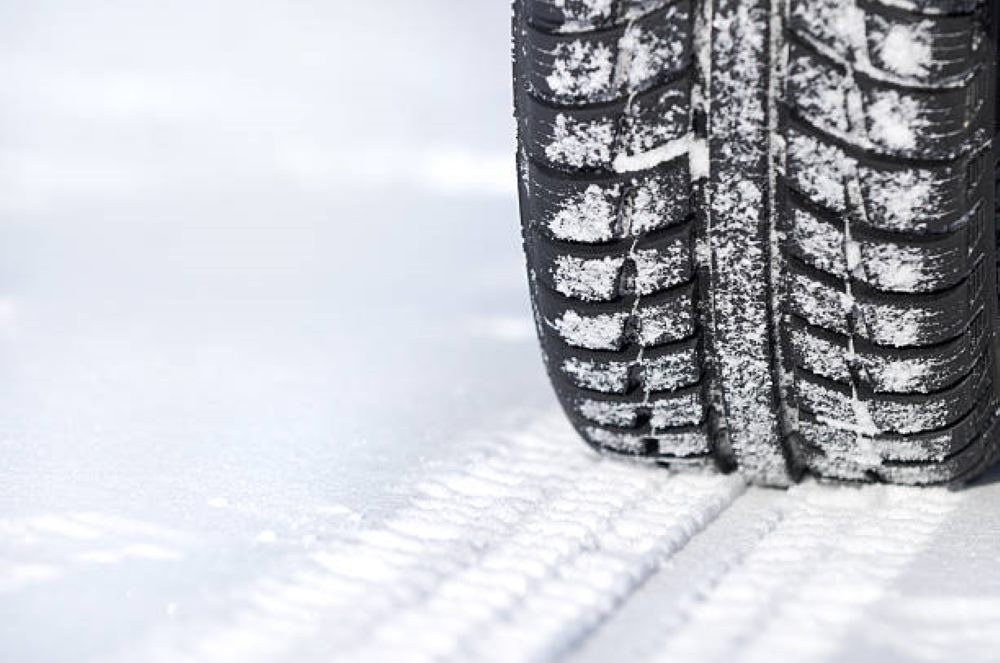Winter tires are a crucial investment for drivers in Toronto. As the temperatures drop and snow starts to fall, the right set of tires can make all the difference in ensuring a safe and comfortable driving experience. But when is the best time to make the switch, and what are the benefits of using winter tires over all season alternatives?
In this comprehensive guide, we delve into the ideal time to change to winter tires, their advantages in Toronto’s climate, the difference between all season and winter tires, the impact on insurance premiums, and proper installation and maintenance. So, buckle up and let’s get started on this journey towards safer and more efficient winter driving.

Key takeaways
- Switch to winter tires in Toronto when the temperature begins to drop below 7°C for enhanced traction and shorter braking distance.
- Alternating between all season and winter tires can extend tire lifespan while providing effective performance in various weather conditions.
- Installing winter tires may lead to reduced insurance premiums, but proper installation and maintenance are essential for their effectiveness.
The ideal time for winter tire change in Toronto

Every driver in Toronto should be aware of the optimal time to switch to winter tires. With such a large province, weather patterns and temperatures can vary greatly, so it’s important to pay attention to the specific conditions in your area. Generally, the ideal time for a winter tire change in Toronto is when temperatures consistently drop below 7°C, which usually occurs between late October and mid November.
Delaying the installation of winter tires may increase the risk of accidents or collisions as the rubber in all season tires stiffens in cold temperatures, reducing their effectiveness on icy roads or snowy roads. To maximize safety and performance, you should consider the right time to change winter tires ahead of the first snowfall.
Temperature threshold – changing summer tires
Switching to winter tires becomes necessary when the temperature consistently falls below 7°C. (sub zero temperatures) This is because the rubber in all season tires starts to harden and become less effective when temperatures fall below this threshold, making them less suitable for icy or snowy weather. Therefore, it’s crucial to change your winter tires during these colder months.
In Toronto, the average time of the year when temperatures drop consistently below 7°C is in January. Planning your tire change schedule altogether is key for maintaining safety and optimal performance during the winter, since the effectiveness of winter tires is affected by decreasing temperatures.
Weather patterns
Beyond temperature tracking, monitoring weather patterns and forecasts can also help you determine the best time to switch to winter tires in Toronto. The first snowfall typically occurs in November, although it may arrive as early as October. While weather forecasting isn’t an exact science, staying up to date with the latest forecasts and being prepared for changing weather conditions can help you make the right decision on when to switch to winter tires.
Advantages of winter tires in Toronto’s climate

Winter tires offer a multitude of benefits in Toronto’s frosty and snow laden climate. Their design and composition are specifically tailored to handle freezing temperatures and icy or snowy weather, ensuring safer driving conditions.
Canadian drivers who invest in high quality winter tires can benefit from both safety on the road and potential cost savings. In the next sections, we will explore the enhanced traction and shorter braking distances provided by winter tires, giving you all the reasons to make the switch.

Enhanced traction – winter tires installed
Increased traction on icy and snowy roads, leading to improved vehicle control and safety, is one of the most notable benefits of winter tires. The specialized rubber compound of winter tires remains flexible in low temperatures, allowing them to maintain traction and grip on icy or snowy surfaces.
Winter tires, also known as snow tires, are equipped with:
- Tread patterns.
- Tread rubber.
- Biting edges.
- Optional studs.
It’s important to have your winter tires changed for optimal performance in snowy conditions.
These components work together to provide enhanced grip and control in winter driving conditions. This flexibility allows the tires to conform to the road, thereby maximizing contact and improving traction for better acceleration, handling, and braking in winter conditions.
Shorter braking distance
Winter tires offer several benefits for driving in Toronto’s winter conditions:
- They shorten braking distances, decreasing the chances of accidents.
- The specialized rubber compound remains flexible in low temperatures, maintaining traction and grip on icy or snowy roads.
- The increased grip allows the tires to effectively transfer braking force to the road, resulting in shorter stopping distances compared to regular tires.
Furthermore, the unique tread pattern of winter tires helps to channel water, slush, and snow away from the tire’s contact patch, further improving traction and reducing the risk of hydroplaning.
All season vs. winter tires: Understanding the difference

Although standard tires might seem like a year round convenience, they fall short in comparison to winter tires during cold spells. In fact, alternating between winter and all weather tires can improve overall tire lifespan and efficiency, as each type of tire is specifically designed for optimal performance in different weather conditions.
Subsequent sections will highlight the performance disparities between all season and winter tires in cold weather, and explain how rotating between the two can extend the life and efficiency of both sets.
Performance in cold temperatures
Winter tires are specifically designed for better performance in cold temperatures, while all-season tires may not provide adequate traction in icy or snowy conditions. The rubber compound of winter tires remains flexible in cold temperatures, ensuring optimum grip on slippery roads and improved traction in snow and ice.
In contrast, the tread rubber of all seasons tires stiffens when the temperature drops, reducing the amount of traction and making them less suitable for winter driving conditions. This difference in performance can have a significant impact on safety and vehicle control during the winter months.

Lifespan and efficiency
Rotating between winter and all season tires can enhance the overall lifespan and efficiency of your tires. Using winter tires during the winter season and transitioning to all season tires in milder weather can prolong the lifespan of both types of tires. This strategy not only ensures optimal performance in various weather conditions but also saves money in the long run by reducing the need for frequent tire replacements.
Lower insurance rates
Installing winter tires can lead to lower insurance rates, saving drivers money on their premiums. In Ontario, drivers who use winter tires may be eligible for a reduction of up to 5% in their insurance premiums. This is not only a financial incentive but also encourages safer driving practices during the winter months when road conditions can be treacherous.
Contacting your provider
To inquire about potential discounts for using winter tires, you can take the following steps:
- Contact your insurance provider or consult with an insurance advisor.
- They will provide you with the necessary information and guide you through the process of obtaining the discount.
- This may require providing proof of winter tire usage, such as receipts, invoices, or photographs.
Proper installation and maintenance of winter tires

The correct installation and maintenance of winter tires are key to ensuring their best performance and extending their lifespan. By ensuring your winter tires are installed correctly and cared for during the off season, you can extend their lifespan and maintain their effectiveness in providing a safe and comfortable driving experience.
In the following sections, we will discuss the proper installation of winter tires and provide tips on tire storage and care.
Installing winter tires
You can ensure the correct installation of winter tires by using the right tools or seeking assistance from a licensed mechanic. The process involves placing wheel chocks or blocks, loosening the wheel nuts, lifting the car with a jack, removing the wheel, mounting the winter tire, placing the wheel back onto the vehicle, tightening the nuts, and lowering the car back to the ground.
It’s important to note that four winter tires should be mounted on all wheels of the vehicle and properly rotated for optimal performance. By following these steps and practicing the installation process, you can ensure a safe and secure driving experience in Toronto’s winter conditions.
Tire storage and care
Proper storage and maintenance of your winter tires during the off season can extend their lifespan and preserve their effectiveness. Store winter tires in a cool, dry, clean, indoor environment when not in use for extended periods, and clean the insides of the tires, removing any moisture or air prior to storage.
Additionally, regularly inspect tire pressure, especially before highway driving or longer trips, to ensure optimal performance and safety on the road.
Summary
In conclusion, changing to winter tires at the right time and understanding their advantages are crucial for drivers in Toronto. Winter tires provide enhanced traction and shorter braking distances, ensuring safer driving conditions in the city’s cold and snowy climate.
By alternating between all season and winter tires, drivers can improve overall tire lifespan and efficiency, while also potentially benefiting from lower insurance premiums. Proper installation and maintenance are essential for optimal performance and longevity. So, equip your vehicle with the right set of tires and stay safe on the road this winter season.
Frequently asked questions
When should I put my winter tires on in Ontario?
It is recommended to switch to winter tires in Ontario once there are seven consecutive days with temperatures below 7°C, which usually happens from late October to mid November. Remember that while winter tires are not mandatory, they can result in lower insurance premiums and other savings.
What is the difference between all season and winter tires?
Winter tires have a softer rubber compound and more aggressive tread pattern to provide better traction in colder temperatures, while all season tires are designed for year round use but may not perform as well in icy or snowy conditions.
